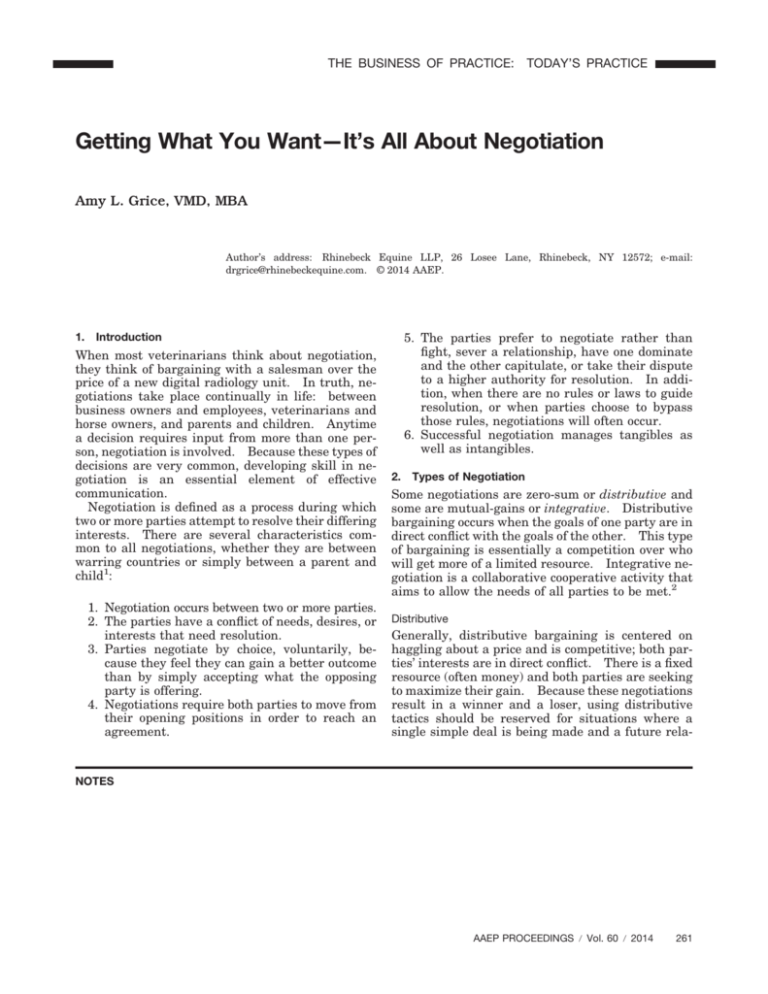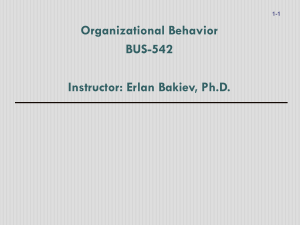Getting What You Want—It's All About Negotiation
advertisement

THE BUSINESS OF PRACTICE: TODAY’S PRACTICE Getting What You Want—It’s All About Negotiation Amy L. Grice, VMD, MBA Author’s address: Rhinebeck Equine LLP, 26 Losee Lane, Rhinebeck, NY 12572; e-mail: drgrice@rhinebeckequine.com. © 2014 AAEP. 1. Introduction When most veterinarians think about negotiation, they think of bargaining with a salesman over the price of a new digital radiology unit. In truth, negotiations take place continually in life: between business owners and employees, veterinarians and horse owners, and parents and children. Anytime a decision requires input from more than one person, negotiation is involved. Because these types of decisions are very common, developing skill in negotiation is an essential element of effective communication. Negotiation is defined as a process during which two or more parties attempt to resolve their differing interests. There are several characteristics common to all negotiations, whether they are between warring countries or simply between a parent and child1: 1. Negotiation occurs between two or more parties. 2. The parties have a conflict of needs, desires, or interests that need resolution. 3. Parties negotiate by choice, voluntarily, because they feel they can gain a better outcome than by simply accepting what the opposing party is offering. 4. Negotiations require both parties to move from their opening positions in order to reach an agreement. 5. The parties prefer to negotiate rather than fight, sever a relationship, have one dominate and the other capitulate, or take their dispute to a higher authority for resolution. In addition, when there are no rules or laws to guide resolution, or when parties choose to bypass those rules, negotiations will often occur. 6. Successful negotiation manages tangibles as well as intangibles. 2. Types of Negotiation Some negotiations are zero-sum or distributive and some are mutual-gains or integrative. Distributive bargaining occurs when the goals of one party are in direct conflict with the goals of the other. This type of bargaining is essentially a competition over who will get more of a limited resource. Integrative negotiation is a collaborative cooperative activity that aims to allow the needs of all parties to be met.2 Distributive Generally, distributive bargaining is centered on haggling about a price and is competitive; both parties’ interests are in direct conflict. There is a fixed resource (often money) and both parties are seeking to maximize their gain. Because these negotiations result in a winner and a loser, using distributive tactics should be reserved for situations where a single simple deal is being made and a future rela- NOTES AAEP PROCEEDINGS Ⲑ Vol. 60 Ⲑ 2014 261 THE BUSINESS OF PRACTICE: TODAY’S PRACTICE tionship with the other party is not important, or an integrative negotiation has progressed to the point of each side “claiming value.” An equine veterinarian purchasing a used truck from a car salesman would do well to use distributive bargaining techniques. In distributive bargaining, each party has in mind a target point: their optimal goal of the point at which negotiations will conclude. They also have a resistance point, beyond which they will break off negotiations and walk away. The opening offer will serve as an anchor for the negotiation and is very important because all moves will take place around this initial stake in the ground. If opening offers (whether from seller or buyer) are too far from the target point, it is possible that no negotiation will even occur. For instance, if the used truck salesman states that the truck’s price is $35,000 but the target point of the prospective buyer is $15,000, it is quite unlikely that a negotiation will occur; the buyer will assume she cannot afford the vehicle. The spread between the buyer’s and seller’s resistance points is known as the bargaining range, because any offer outside of this range will be immediately rejected by the other party. If the truck salesman’s lowest acceptable price (his resistance point) for the used truck is $20,000, he will summarily dismiss an offer of $15,000. Through the process of making offers and counteroffers: each party begins to reveal their resistance point. Consider a seller with an opening price of $30,000, a target of $25,000, and a resistance point of $20,000 bargaining with a buyer with a target of $17,500 and a resistance point of $22,500. One can see that the bargaining range is between $20,000 and $22,500. Within a few minutes of conversation, both parties will understand the others’ position better and a deal may be made that satisfies both parties. A positive bargaining range occurs when the buyer’s resistance point is above the seller’s. In the case of a negative bargaining range, the seller has a minimum price higher than the maximum the buyer is willing to pay. Either the negotiation will end or the parties will re-evaluate their resistance points. Or the buyer will pursue an alternative. The best alternative to a negotiated agreement (BATNA) is a critical concept for all negotiators. Alternatives are important because they give negotiators the power to walk away from a deal that is not attractive. Knowing the best alternative to an agreement before entering into a negotiation is critical to making good decisions. Because of their awareness of their true “bottom line,” negotiators with a firm understanding of their BATNA have power and confidence and, generally, are more successful in achieving their goals.3 If the veterinarian has identified another used truck at another dealership with an asking price of $22,500 (her BATNA) she will be much more likely to press the salesman for a sale price on the subject truck closer 262 2014 Ⲑ Vol. 60 Ⲑ AAEP PROCEEDINGS to her target and less likely to agree to a price close to her resistance point. The basic strategies in distributive bargaining are to push for a price very close to the seller’s resistance point by making extreme offers and small concessions and/or convince the seller to reconsider his resistance point by influencing his beliefs about the value of what he is selling. Because during negotiations concessions are essential, opening offers should be sufficiently distant from the resistance point to allow room for an exchange of offers. Research shows that parties are more satisfied with agreements if there is a series of concessions rather than if their first offer is accepted, perhaps because they feel they could have done better.4 When making concessions, one can determine when a counterpart’s resistance point is being reached as successive concessions become smaller. Although a few people approach all discussions as though they were distributive bargaining sessions, reserving this approach for those situations that are truly one-time transactional agreements with no relationship components is the most rewarding approach. Integrative The goals of the negotiating parties in integrative negotiation are not mutually exclusive: this is winwin bargaining. In this type of negotiation, there is a focus on what is found in common rather than on differences, on interests rather than positions, on meeting the needs of all parties, on an exchange of information between sides, and on an enlargement of the pie through innovative ideas. In order to be a successful integrative negotiator one must build trust through honesty and integrity, have a positive outlook that sees abundance rather than scarcity, recognizes that others’ interests have equal validity as yours, be able to see the big picture, and have strong listening skills.5 By facilitating a reciprocal flow of information, both sides gain understanding of the needs and concerns of their counterparts, leading to less extreme resistance points. Identification of the others’ true objectives and desired outcomes can lead to recognition of commonalities and areas of alignment. This makes searching for solutions that meet both sides’ goals more successful and satisfying. By generating multiple alternatives, innovative solutions may arise that increase overall value. As an example, an associate may want to pursue acupuncture training but the tuition and time away needed exceed her contractual continuing education budget and allotted days off. An active dialogue is needed, focusing on understanding the costs, benefits, goals, and threats of this desire. By defining all of the parameters of this “problem” collectively, both the associate’s and the practice’s needs and priorities can be accurately identified. The practice may have concerns about the tuition fees, travel costs, and lost time in production/emergency duty, THE BUSINESS OF PRACTICE: as well as concerns about future loss of this employee after paying for the acquisition of these skills. The associate desires to add an additional profit center to the practice to increase her value as an employee and increase her potential earnings. She also desires to add a skill that she could pursue in the future in her own practice if she decides that emergency duty is a poor lifestyle once she becomes a parent. A collaborative approach to this situation where all concerns as well as aspirations are voiced has a high likelihood of producing an agreement that honors the needs of all parties. One creative solution would have the practice pay the associated expenses in return for an agreement that a certain number of subsequent years of service were required or repayment of prorated expenses would be stipulated if the associate departed prematurely. One can easily imagine the associate’s poor morale if the request was simply denied, or the practice owner’s anger and feelings of betrayal if an associate promptly departed after training financed by the practice without a repayment clause. Both parties must think of what their BATNA is in this situation. The associate’s BATNA might be to pay for the training herself and utilize vacation time in order to attend. The practice’s BATNA could be to give the associate unpaid leave to attend the course, with her assuming all expenses in excess of her continuing education budget. When assessing these BATNAs, it is clear that a negotiated settlement is likely to be more satisfactory for all parties. All successful negotiations require careful preparation, including determination of the BATNA, the target point, the resistance point, and the opening offer. Integrative bargaining requires the additional steps of defining the problem, identifying both parties’ needs and interests, collaboratively generating alternative solutions, and selecting a solution after careful evaluation of the value created by the choices generated.6 3. Negotiation Styles Different individuals have varied innate preferred negotiating styles. These include avoidance, compromise, accommodation, competitive, and collaborative. By understanding one’s own preferences and being aware of the potential for others to have differing styles, a person can become more comfortable with experimenting with other negotiating styles. A cooperative approach is often more effective than a competitive one and an awareness of personal preferences can lead to better outcomes. Simple assessment exercises are available that reveal preferred negotiating styles. Gender and culture also play a part in negotiating styles.7 Dr. G. Richard Snell, a professor at the Wharton School of Business, created an assessment tool for negotiation style, printed as an Appendix in his book Bargaining for Advantage.8 The results of this assessment can reveal a preferred style of negotiation. Those with strongly accommodating styles have TODAY’S PRACTICE strong skills in relationship building and enjoy helping solve others’ problems. They can excel in many customer service roles and integrative bargaining situations, but can be vulnerable to competitive counterparts. They may sometimes place more value on relationships than warranted by the situation. Those with weak accommodation often focus on being “right” and have difficulty seeing other perspectives. Others may see them as stubborn and unreasonable, or uncaring about others’ feelings. Negotiators that are predisposed to compromising are eager to find an agreement that will close the negotiation. Seen as friendly and reasonable, compromisers often grasp the first fair solution that presents itself and are vulnerable to choices made without adequate fact-finding. Those low on compromising often have strong principles and passion, but are subject to standing on principle when common sense dictates otherwise; they can be seen as stubborn and irritating. People that favor avoiding dislike confrontation and will dodge all situations that lead to disagreement. This can manifest as diplomacy and tact and can be very helpful in tense negotiations. Wellhandled conflict avoidance can bring difficult groups to agreement. However, important information is often not brought into the open due to fear of difficult conversations. Those who have low avoiding preferences have a high tolerance for assertive or even aggressive conversation. They are often seen as lacking tact or being overly confrontational. However, they can be valuable in some bargaining situations. Those predisposed to collaborating enjoy solving tough problems through negotiation and work hard to find a best solution. When negotiations reach claiming value stages, these people may fail to gain their share of the resources due to their wish to build consensus and are vulnerable to competitive negotiators. Those low in collaborating prefer a more controlled detail oriented process and may lose clarity and focus in the seeming chaos of a group setting. Negotiators that prefer competing like to win and they enjoy negotiating because it provides a contest. Although highly skilled in the processes of negotiation, their style is dominating and can damage relationships. Because intangibles are difficult to assign a value to, they often focus on the tangible aspects of bargaining, leaving value on the table. Those low on competing value fairness and trust, but because they are seen as non-threatening, in some situations they will be at a disadvantage. Although people have preferred styles, becoming comfortable with recognizing, working with, and practicing other styles is important, since your counterparts in negotiation may have a different preferred style. Depending on the bargaining situation in which you find yourself, your style may help you be more successful or be a source of weakness. Self-awareness can help you mitigate the negative effects and capitalize on the positive. AAEP PROCEEDINGS Ⲑ Vol. 60 Ⲑ 2014 263 THE BUSINESS OF PRACTICE: TODAY’S PRACTICE Table 1. Strategies for Negotiations Degree of conflict Importance of Future Relationship High Low 4. High Low 1. Balanced (business partnership, joint venture, committee) 2. Relationships (marriage, friendship, work team) Best strategies: Collaboration Compromise Best strategies: Accommodation Collaboration Compromise 3. Transactions (market transaction, practice sale, house sale, divorce) 4. Tacit conflict avoidance through cooperation (roadway intersection, airplane seating) Best strategies: Competition Collaboration Compromise Best strategies: Avoidance Accommodation Compromise Steps for Integrative Negotiation e. Attempt to expand the pie, creating additional value. 7. Evaluate solutions on the basis of the criteria previously determined. a. Narrow choices by rank ordering. b. Judge solutions on how good they are and how they will be accepted by those implementing them. c. Consider combining options into packages that please multiple interests. d. Try to reach consensus rather than voting in order to have full commitment by all parties for implementation of negotiated settlement. 8. Formalize the agreement, A sequence of steps for an integrative negotiation can be followed as a collaborative activity: 1. What is the problem? a. Depersonalize it. b. State the problem as a specific goal to be attained. c. Explore all possible aspects of the problem. d. Explore all related issues. e. What is most important? What is least important? 2. What obstacles must be overcome to achieve the goal? 3. What interests are present? Interests are underlying concerns, needs, desires and fears that motivate a negotiator to take a particular position. a. Are they substantive? (related to the focus of the negotiation) b. Are they process-oriented? (related to how the negotiation unfolds) c. Are they relationship-based? (related to value placed on relationships) d. Are they interests “in principle”? (related to fairness or values) 4. Explore why certain solutions are wanted by certain parties: why do they want what they want? 5. What criteria will be used to judge proposed solutions? Agree on criteria before generating solutions. 6. What are possible solutions to solve the problem? a. Generate multiple alternatives. b. Avoid judging or evaluating solutions while brainstorming. c. Avoid ownership of solutions. d. Ask outsiders. 264 2014 Ⲑ Vol. 60 Ⲑ AAEP PROCEEDINGS 5. Strategies for Negotiations Strategies for negotiations can be chosen from a model that balances the importance of future relationships with the perceived degree of conflict. Used along with self-awareness of preferred style, one can confidently take an approach to resolve differences using recommended strategies (Table 1).9 You will notice that the strategies listed mirror the styles discussed earlier. In the broader categories of cooperative and competitive strategies, both have strengths and weaknesses and can be effective in different circumstances. However, multiple studies have shown that the most successful negotiators, even in professional settings such as union negotiations, are cooperative rather than competitive.10 This is reflected in the preference for cooperative strategies given in the rubric. 6. Conclusion Negotiation is unavoidable and takes place regularly during the ordinary events of our work and personal lives. Understanding the difference between distributive and integrative negotiations, knowing our preferred negotiation styles, being fa- THE BUSINESS OF PRACTICE: miliar with the process of an effective negotiation, and understanding the best strategies for different situations all can contribute to negotiation with more satisfying outcomes. Acknowledgments Conflict of Interest The Author declares no conflicts of interest. References 1. Lewicki, RJ, Saunders, DM, Barry B. Essentials of negotiation. New York: McGraw-Hill Irwin, 2012;8. 2. Lewicki, RJ, Saunders, DM, Barry B. Essentials of negotiation. New York: McGraw-Hill Irwin, 2012;10. TODAY’S PRACTICE 3. Lewicki, RJ, Saunders, DM, Barry B. Essentials of negotiation. New York: McGraw-Hill Irwin, 2012;32. 4. Lewicki, RJ, Saunders, DM, Barry B. Essentials of negotiation. New York: McGraw-Hill Irwin, 2012;44. 5. Lewicki, RJ, Saunders, DM, Barry B. Essentials of negotiation. New York: McGraw-Hill Irwin, 2012;63. 6. Lewicki, RJ, Saunders, DM, Barry B. Essentials of negotiation. New York: McGraw-Hill Irwin, 2012;66. 7. Snell, GR. Bargaining for advantage. New York: Penguin, 2006:8 –17. 8. Snell, GR. Bargaining for advantage. New York: Penguin, 2006:237. 9. Snell, GR. Bargaining for advantage. New York: Penguin, 2006:165. 10. Snell, GR. Bargaining for advantage. New York: Penguin, 2006:14. AAEP PROCEEDINGS Ⲑ Vol. 60 Ⲑ 2014 265







